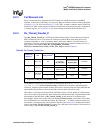
258 Hardware Reference Manual
Intel
®
IXP2800 Network Processor
Media and Switch Fabric Interface
Table 93 summarizes the differences in RBUF operation between the SPI-4 and CSIX protocols.
8.2.7 Receive Flow Control Status
Flow control is handled in hardware. There are specific functions for SPI-4 and CSIX.
8.2.7.1 SPI-4
SPI-4, FIFO status information is sent periodically over the RSTAT signals from the Link Layer
device (which is the IXP2800 Network Processor) to the PHY device. (Note that TXCDAT pins
can act as RSTAT based on the MSF_Rx_Control[RSTAT_Select] bit.) The information to be sent
is based on the number of RBUF elements available to receive SPI-4.
The FIFO status of each port is encoded in a 2-bit data structure — code 0x3 is used for framing the
data, and the other three codes are valid status values. The FIFO status words are sent according to
a repeating calendar sequence. Each sequence begins with the framing code to indicate the start of
a sequence, followed by the status codes, followed by a parity code covering the preceding frame.
The length of the calendar is defined in Rx_Calendar_Length, which is a CSR field that is
initialized with the length of the calendar, since in many cases fewer than 256 ports are in use.
When TRAIN_DATA[RSTAT_En] is disabled, RSTAT is held at 0x3.
The IXP2800 Network Processor transmits FIFO status only if TRAIN_DATA[RSTAT_En] is
set. The logic sends “Satisfied,” Hungry,” or “Starving” based on either the upper limit of the
RBUF, a global override value set in MSF_Rx_Control[RSTAT_OV_VALUE], or a port-specific
override value set in RX_PORT_CALENDAR_STATUS_#. The choice is controlled by
MSF_RX_CONTROL[RX_Calendar_Mode].
When set to Conservative_Value, the status value sent for each port is the most conservative of:
• The RBUF upper limit
• MSF_RX_CONTROL[RSTAT_OV_VALUE]
• RX_PORT_CALENDAR_STATUS_#
“Satisfied” is more conservative than “Hungry,” which is more conservative than “Starving.”
Table 93. Summary of SPI-4 and CSIX RBUF Operations
Operation SPI-4 CSIX
When is RBUF Element
Allocated?
Upon receipt of Payload Control Word or when Element data
section fills and more Data Words arrive. The Payload
Control Word allocates an element for data that will be
received subsequent to it.
Start of Frame and Base Header Type
is mapped to RBUF (in the
CSIX_Type_Map CSR).
How Much Data is Put
into Element?
All Data Words received between two Payload Control
Words, or number of bytes in the element, whichever is less.
Number of bytes specified in Payload
Length field of Base Header.
How is RBUF Element
Set Valid?
Upon receipt of Payload Control Word or when Element data
section fills. The Payload Control Word validates the element
holding data received prior to it.
All Payload is received (or if
premature SOF, which will set an
error bit in Element Status).
How is RBUF Element
Handed to Microengine?
Element Status is pushed to Microengine at the head of the appropriate Rx_Thread_Freelist_#
(based on the protocol). Status is pushed to two consecutive Transfer registers; bits[31:0] of Element
Status to the first Transfer register and bits[63:32] to the next higher numbered Transfer register.
How is RBUF Element
returned to free list?
CSR write to RBUF_Element_Done.


















